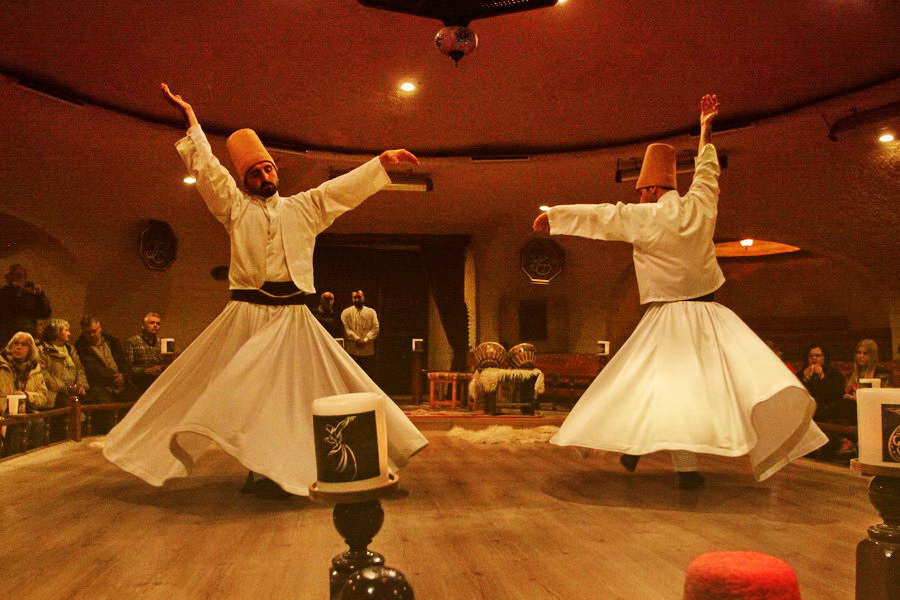Turkish Folk Dances

The culture of the Turkish people has evolved over the centuries. You can see it reflected in their traditional costumes, language, national festivals, art, music, and, of course, dances. Let’s look at the Turkish folk dances, various styles, and features.
Few people know that Turkey has around 400 dance styles, among which the famous Turkish dances are:
- Zeibek
- Halay
- Bar
- Hora
- Horon
- Kasik
Zeibek – Turkish Dancing Men
The word Zeibek stood for “warrior,” and it was used to describe fighters in people’s militia. As time passed, the word remained in folklore alone. Turkish folk dance Zeibek is considered a traditional men’s dance increasingly common across the Mediterranean regions, in cities like Izmir, Aydin, Mula, Bilecik, Denizli, and others.
Each movement in the dance is designed to showcase bravery and heroism. Dancers begin with slow steps and then speed up along with the music. The main dance pattern symbolizing the soldier’s strength is a twist on one leg, touching the ground with the knee and straightening up.
This choreography is repeated in a circular pattern in rhyme to a slow zurna pipe and davul drumbeat.
Halay
One of the most popular traditional Turkish dances, particularly in Bitlis, Bingol, Diyarbakir, Elazig, Gaziantep, Erzurum, Erzincan, and other cities in the east and south-east of the country, is Halay.
During the dance, men and women form a circle or a line, intertwining their hands or fingers. A person who closes the circle or the line, holds a handkerchief called mendi. All dancers make identical steps, moving in a circle in time to the music. The tempo is slow in the beginning and speeds up at the end.
Halay is an ancient dance style dating back to the time of Assyrian dominance, and other countries in the Middle East have a similar dance. However, Turks believe it is linked to Central Asia pagan rituals, which often included circular dances around a fire.
Today, Turks still dance a Halay around a fire on certain occasions and holidays. It’s also the most common Turkish traditional wedding dance. Halay might derive from “Alay,” meaning “many people” and alluding to unity and cooperation.
Horon
Horon is particularly favored in the Black Sea Region (Rize, Trabzon, Samsun, and Ordu). The name is derived from the Greek Χορός, meaning dance in ancient and modern Greek. But Turks associate it with the Turkish origin of the word “horom,” meaning a stack of corn.
Dancers form a circle or semi-circle and first dance slowly, and then increase in tempo, bending and spinning, and tapping their feet in time to music accompanied by a tulum and a string instrument kemence.
Bar
Popular all over the region of Eastern Anatolia, the Bar can be danced by women and men.
Men typically are gathered in a group of 16, while women in a group of 12. There’s a bar dance, featuring a closed position, when dancers approach each other closely, and an open position, when there’s a certain distance between dancers.
This Turkish folk dance performed by women is soft and smooth, but more emotional and rhythmic when danced by men. The Bar is accompanied by zurna and davul, and sometimes, songs.
Hora
Hora, another traditional Turkish dance, originated in Thrace and is popular in Western Anatolia. Accompanied by zurna and davul, dancers in colorful outfits make a line, which involves footwork forwards. The tempo is usually fast and rhythmic.
Kasik
In Turkish, kasik translates as “a spoon.” So, the dance is performed with spoons. Dancers stand in two lines facing each other and tapping rhymes with wooden spoons.
It is believed that Kasik originated in Turkey and has become popular throughout the Mediterranean region.
Where to See Traditional Turkish Dance Shows?
The Hodjapasha Cultural Center in Istanbul is a popular venue for Turkish dance shows – spectacular music shows and colorful costumes, including male and female belly dancing. Before the performance, you will be introduced to a historical timeline from the early ages to get a glimpse of Turkish dances.

